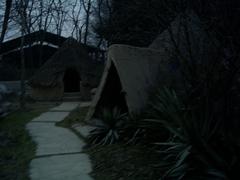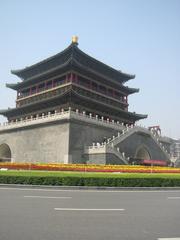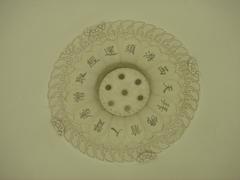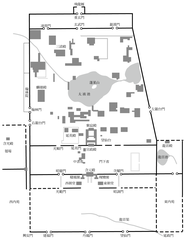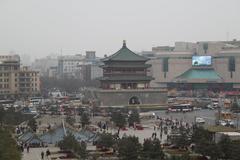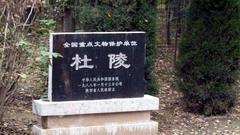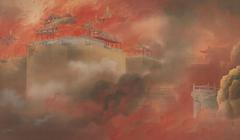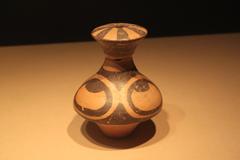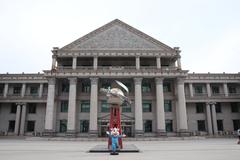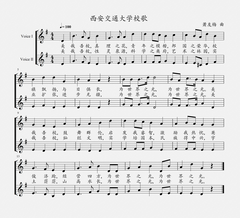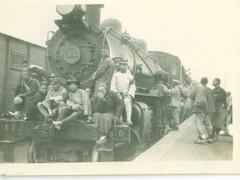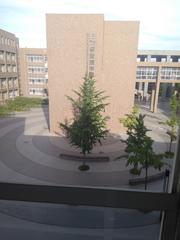Xi’an Beilin Museum: Visiting Hours, Tickets, and Historical Site Guide
Date: 14/06/2025
Introduction
The Xi’an Beilin Museum, also known as the Forest of Stone Steles Museum or Stele Forest, is a cultural jewel nestled within Xi’an’s ancient city walls. Celebrated for its unparalleled collection of stone inscriptions, calligraphy, and historical artifacts, the museum offers visitors a profound journey through over two millennia of Chinese civilization. Established during the Northern Song Dynasty to safeguard monumental relics, the museum today stands as the largest and most comprehensive collection of stone steles in China. Its location within the historic Confucius Temple complex, surrounded by elegant Ming and Qing dynasty architecture, creates a contemplative atmosphere that draws scholars, art lovers, and curious travelers alike.
This guide provides an in-depth look at the Xi’an Beilin Museum’s origins, architectural features, key exhibits, and practical information for visitors. Whether your interest lies in Chinese art, history, or simply experiencing the cultural richness of Xi’an, the Beilin Museum is a must-see destination. For the latest updates and details, consult the official Beilin Museum website and trusted sources (chinatripedia.com; advantour.com; thesilkroadchina.com).
Table of Contents
- Introduction
- Historical Background
- Museum Architecture and Layout
- Notable Collections and Artifacts
- Cultural and Scholarly Significance
- Conservation and Modernization
- Visitor Information
- Visual Resources and Virtual Experience
- Frequently Asked Questions (FAQ)
- Conclusion
- References
Historical Background
Origins and Development
The Xi’an Beilin Museum traces its origins to 1087 CE, during the Northern Song Dynasty. It was founded to preserve the “Classic on Filial Piety” (Shitai Xiao Jing Stele) after the monumental Tang dynasty tablet was threatened by flooding. Over subsequent centuries, the museum’s collection expanded significantly, incorporating over 3,000 steles dating from the Han through Qing dynasties. The museum’s name, “Beilin” or “Forest of Steles,” reflects the dense arrangement of these stone monuments throughout its galleries and courtyards (chinatourguide.com; chinatripedia.com).
Originally a Confucian temple, the site evolved into a museum as part of national efforts to preserve cultural heritage. In 1961, it was designated as a nationally protected historical site (english.dbw.cn).
Museum Architecture and Layout
Confucius Temple Complex
The museum is housed within the historic Temple of Confucius, a complex dating from the Ming and Qing periods. Visitors enter through grand gateways and pass tranquil features such as the Banchi Pool, ornate cloud pillars, and symbolic archways. The architectural ensemble fosters a contemplative environment, reinforcing the museum’s scholarly and moral heritage (thesilkroadchina.com).
Exhibition Halls and Galleries
- Eight Stele Halls: These contain the largest and most significant steles, including the iconic Shitai Xiao Jing Stele.
- Seven Showrooms: Thematically or chronologically arranged, these feature smaller steles, stone sculptures, and related artifacts.
- Six Stele Galleries: Open-air spaces where steles are displayed in “forest” formation, enhancing the immersive experience.
The overall layout covers more than 31,000 square meters, blending courtyards, pavilions, and exhibition spaces in the style of traditional Chinese academies (chinatripedia.com).
Notable Collections and Artifacts
Stele Collection
The Beilin Museum’s collection is the largest of its kind, comprising over 3,000 steles and more than 7,000 artifacts in total (chinatripedia.com; advantour.com). These steles span nearly two millennia and serve as primary sources for the study of literature, calligraphy, philosophy, history, and religious diversity.
Key Highlights
- Tang Dynasty Stele Collection: 114 tablets inscribed with Confucian classics, key for the study of Chinese literature and philosophy (thesilkroadchina.com).
- Nestorian Stele: A 781 CE limestone tablet documenting early Christianity in China, notable for its bilingual inscription and cross-cultural symbolism (advantour.com).
- Kaicheng Classics: Twelve tablets from 837 AD, among the best-preserved Confucian classics (CITS).
- Calligraphic Masterpieces: Works by Ouyang Xun, Yan Zhenqing, Liu Gongquan, and other renowned calligraphers, illustrating the evolution of Chinese script styles (xianprivatetour.com).
- Other Artifacts: Includes the Cao Quan Stele (Han Dynasty), Sima Fang Stele (Jin Dynasty), Kaicheng Shi Jin Stele, Jinyun Bell, Daxia Stone Horse, gold-plated bronze horses, and tiger-shaped tallies.
Stone Sculptures and Rubbings
Beyond steles, the museum features tombstones, animal sculptures, Buddhist and Daoist statues, stone rubbings, and architectural fragments, enriching the narrative of Xi’an’s artistic and religious heritage (WindhorseTour).
Cultural and Scholarly Significance
The Beilin Museum is a living repository of Chinese intellectual, artistic, and religious traditions. Its steles document the evolution of calligraphic styles, commemorate significant events, and reflect the multicultural character of ancient Xi’an—a Silk Road terminus where Buddhist, Daoist, and Christian texts coexisted (advantour.com). The museum’s educational mission is furthered through regular calligraphy demonstrations, art exhibitions, and public programs (chinatripedia.com).
Conservation and Modernization
To protect its ancient artifacts, the museum employs advanced conservation technology, climate control, and restoration protocols. Digital exhibits and virtual tours enhance accessibility for remote visitors and those unfamiliar with classical Chinese (beilin-museum.com).
Visitor Information
Visiting Hours
- General Hours: 8:30 AM – 6:00 PM (last entry at 5:30 PM)
- Seasonal Adjustments: Some sources note opening as early as 8:00 or 9:00 AM, with last entry at 5:00 PM—confirm on the official website or by phone (Trip.com).
Tickets and Reservations
- Standard Admission: ¥50–¥85 (check for current rates)
- Discounts: Available for students, seniors, military, children under 1.2 meters, and people with disabilities (valid ID required)
- Purchase: Tickets available onsite or online via official platforms; advance reservation may be required during peak periods (beilin-museum.com)
- Capacity: Daily visitor limits may apply; sales close when capacity is reached.
Accessibility
- Physical Access: Most main exhibition areas are wheelchair-accessible; historic paths may be uneven, but staff assistance is available.
- Facilities: Rest areas, bilingual signage, and accessible restrooms provided.
Guided Tours and Events
- Guided Tours: Available in multiple languages; inquire at the visitor center or online.
- Audio Guides: Offered for a small fee.
- Educational Programs: Regular calligraphy workshops, art exhibitions, and special events—see museum website for schedules.
Getting There and Nearby Attractions
- Location: No. 15 Sanxue Street, Beilin District, Xi’an, within the ancient city walls and near the Bell Tower and South Gate (Trip.com).
- By Subway: Line 2 to Yongningmen (South Gate), then a short walk.
- By Bus/Taxi: Multiple bus stops nearby; taxis widely available.
- Nearby Sites: Xi’an City Wall, Muslim Quarter, Shaanxi History Museum, Big Wild Goose Pagoda.
Practical Tips
- Arrive early to avoid crowds, especially on weekends and holidays.
- Plan for 1.5–3 hours to fully explore.
- Photography (non-flash) is generally allowed; check for restrictions.
- Food options are limited on-site; nearby Muslim Quarter offers diverse cuisine.
Visual Resources and Virtual Experience
- Explore high-quality images and virtual tours on the official website and travel platforms.
- Download maps and audio guides to enhance your visit.
- Consider interactive features and digital exhibits for deeper engagement.
Frequently Asked Questions (FAQ)
Q: What are the Xi’an Beilin Museum’s visiting hours?
A: Typically 8:30 AM – 6:00 PM, last entry 5:30 PM. Confirm on the official website for seasonal variations.
Q: How much are tickets?
A: Standard tickets are ¥50–¥85. Discounts and free entry available for eligible groups.
Q: How do I buy tickets?
A: Purchase onsite or online via the official website; advance reservation recommended during busy times.
Q: Is the museum wheelchair accessible?
A: Most main areas are accessible; staff assistance available for uneven paths.
Q: Are guided tours and audio guides available?
A: Yes, in several languages for a nominal fee.
Q: Can I take photos?
A: Non-flash photography is allowed in most areas; look for signage.
Q: What is the best time to visit?
A: Weekdays and off-peak seasons (autumn/winter) are less crowded.
Conclusion
The Xi’an Beilin Museum stands as a monumental testament to China’s literary, artistic, and multicultural legacy. Situated in the serene Confucius Temple complex, it offers a unique window into the development of Chinese civilization—from the brushwork of calligraphic masters to the cross-cultural exchanges of the Silk Road era. With accessible facilities, engaging exhibits, and proximity to other historic Xi’an sites, the Beilin Museum is an essential stop for anyone seeking to understand China’s rich heritage.
Plan your visit by checking the latest hours and ticket details, book guided tours for deeper insight, and allow ample time to appreciate the museum’s treasures. Enhance your cultural experience by exploring nearby attractions such as the Xi’an City Wall and the Muslim Quarter. For more information and updates, consult the Beilin Museum website and leading travel resources.
References
- Xi’an Beilin Museum: A Complete Guide to History, Architecture, and Visitor Information, 2025, chinatourguide.com
- Beilin Museum Xi’an: Visiting Hours, Tickets, and Historical Highlights, 2025, chinatripedia.com
- Beilin Museum Xi’an: Visiting Hours, Tickets, and Must-See Exhibits, 2025, WindhorseTour
- Visitor Experience, Accessibility, and Practical Tips, 2025, Trip China Guide
- Xi’an Beilin Museum Official Website, 2025, beilin-museum.com
- The Silk Road China: Xi’an Stele Forest Museum, 2025, thesilkroadchina.com
- Advantour: Beilin Museum in Xi’an, 2025, advantour.com
- English DBW: Nationally Protected Historical Sites, 2011, english.dbw.cn
